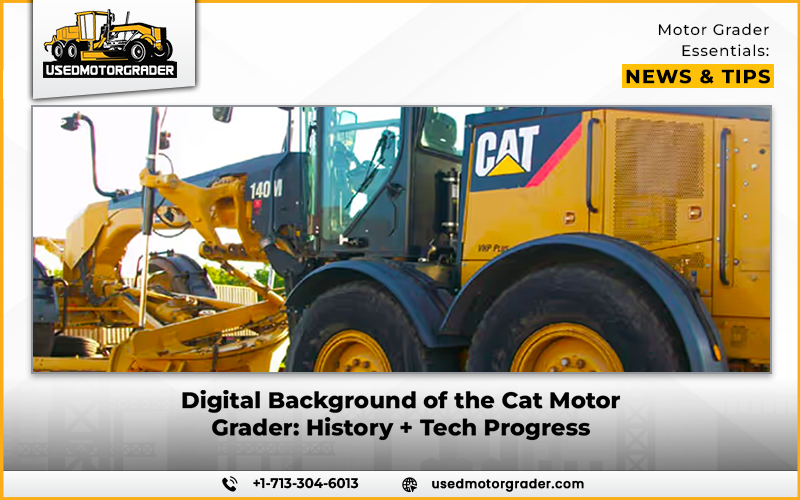There is hardly a machine in the construction industry that has as much history and innovation as the Cat motor grader. Since its inception as a pull-type grader, Caterpillar has been at the forefront of integrating mechanical power with the latest technology. This development is not only a reflection of the transformation of the graders but also a sign of the digitalization of the entire construction industry.
Early History of Cat Motor Graders
The history of Caterpillar graders can be traced back almost 100 years ago when the company specialized in rough and durable machines that could endure harsh working conditions.
Key Historical Milestones:
- 1920s: Pull-type graders were introduced, which used external sources of power such as tractors.
- 1930s-40s: Self-propelled graders were introduced, which provided more freedom and choice to the operator.
- 1950s: Addition of diesel engines, which increased performance and fuel efficiency.
- 1970s: Improved hydraulic systems, which permitted a more accurate and smoother control of the blade.
These pioneer innovations formed the basis of what will be one of the most reliable machines in the heavy equipment industry.
Entry into the Digital Era
Towards the end of the 20th century, the industry started to shift to electronic assistance. Caterpillar was quick to adapt and fitted graders with technology that enhanced the efficiency of the operator and minimized fatigue.
First Digital Innovations:
- Smoother operation with electronic throttle and transmission control.
- Control systems in the early grades permitted more precise surface leveling.
- Monitoring displays that give real-time machine health information.
- Automated changes that reduced the possibility of human error.
This was the beginning of the end of all-mechanical operation and the beginning of the involvement of electronics in precision and productivity.
Technological Progress in Modern Cat Motor Grader Models
The modern Cat motor graders are a much different lot compared to their early predecessors. They combine advanced digital technologies that enhance efficient, accurate, and easier grading by operators.
Current Digital Features:
- Cat Grade Cross Slope automatic blade control.
- Live GPS guidance and 3D grading control of accurate earthmoving.
- Cat Product Link Remote monitoring telematics, which keep contractors in touch with their machines.
- Joystick controls instead of traditional levers, less operator strain, and more accuracy.
These upgrades are a sign of Caterpillar not only creating powerful machines, but also intelligent machines.
Benefits of Digital Integration in Cat Motor Graders
The digital age introduced the benefits of the real world that are not limited to convenience. Modern graders allow contractors to enjoy increased productivity and reduced total costs.
Contractor Digital Benefits:
- Quick project completion and accurate grading.
- Reduced operating expenses due to efficiency.
- Easy-to-use operator training.
- Evidence-based information to make improved decisions.
The digital integration directly translates to savings and increased profitability of the project by minimizing the number of passes required and maximizing the use of fuel.
Comparing Traditional vs. Digital Graders
Whereas the traditional graders established a reputation for durability, the digital graders have reinvented efficiency and operator experience.
Key Differences:
- Precision: manual setting of grades versus automated control of precision.
- Efficiency: several passes are needed compared to fewer passes with digital support.
- Maintenance: mechanical inspection as opposed to smart diagnostics and alerts.
- Learning curve: long operator training vs. digital controls that are easy to use.
This difference can translate to the capacity of many contractors to undertake bigger projects using fewer resources.
Challenges and Future Outlook
Naturally, the transition to digital graders does not come without challenges. Smaller contractors might have cost barriers, and operators usually require retraining to adjust to new technologies. Nevertheless, the course of development is obvious.
Future Directions:
- Combination with fully autonomous construction fleets.
- Predictive maintenance based on AI to prevent unplanned downtime.
- Increased integration with project management in the cloud.
- Greater sustainability through smarter fuel and energy.
Digital advancements appear to be steering the future of the Cat motor grader toward automation, connectivity, and sustainability.
Final Note
Since its mechanical origins, the Cat motor grader has gone through an incredible transformation to the present-day GPS-powered wonders. The capacity to incorporate history with innovation has enabled Caterpillar to remain at the forefront of construction equipment. These graders demonstrate that tradition and technology can be used together with the accuracy, safety, and efficiency of digital features. In the future, the digital advancements will keep expanding the scope of what graders can do on the job site.
FAQs
Q1. When did Caterpillar first introduce digital systems in motor graders?
A: Caterpillar started to add digital capabilities in the late 1980s and early 1990s, and electronic controls and early grade monitoring systems were the first steps toward this.
Q2. What is the benefit of GPS-enabled Cat motor graders?
A: GPS technology enables accurate grading with fewer passes, fuel, time, and lower labor costs, and produces better quality surfaces.
Q3. Do digital motor graders cost more to maintain?
A: Although initial maintenance costs can be a little more expensive with advanced electronics, smart diagnostics can prevent significant breakdowns, which can reduce long-term costs.
Q4. What’s the future of Cat motor graders in terms of automation?
A: Caterpillar is heading to semi-autonomous and ultimately fully autonomous graders, where AI-based systems will improve efficiency and decrease the workload of operators.


